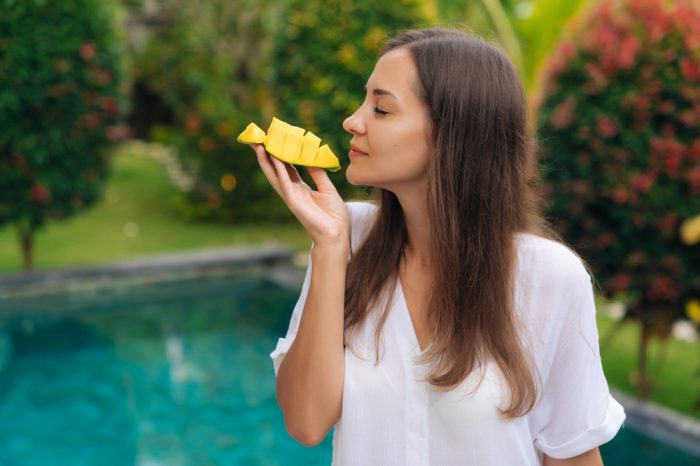You know that urban myth about mangos and how they enhance the effects of THC? Probably not true.
You’ve probably heard this before: If you want to increase or prolong your cannabis high, just eat a mango 45-minutes before smoking. Apparently, mangos and THC are best buds. But this “tip”, like many other claims in cannabis folklore, is likely a myth.
Likely. Maybe.
Most of the “evidence” for the mango trick comes from anecdotal reports on the web. Of course, much of the evidence we have for anything related to cannabis comes from anecdotes, so that alone shouldn’t force us to write off mangos. Furthermore, no one knows where the rumor started, and is some science behind it. It starts with a terpene called myrcene.

Have Mercy Myrcene
Myrcene is a monoterpene that produces an aroma of dirt, wood, and a general earthy stank. Indica chemovars typically produce greater levels of myrcene than their sativa counterparts, which may be one origin of this rumor. Indicas are (inaccurately) characterized as the cannabis that produces the couch-lock effect. (I write “inaccurately” because sativas can make people feel sleepy, too. See: Blue Dream.)
Myrcene possesses sedative effects, confirmed by a few studies that fed myrcene oils to rodents. However, these studies administered obscenely high amounts of myrcene, much higher than the average person would consume when smoking a joint or eating a mango.
One 2014 book illustrated how much myrcene this translates to human-level figures: “The lowest dose used, 250 mg/kg, is equivalent to a 70 kg human ingesting 35 g of an essential oil consisting of 50% β-myrcene. This at least 35 times a therapeutic oral dose, and 100–1,000 times the amount that would be absorbed from a body oil or lotion.”
Other studies indicate myrcene confers psychoactivity. Myrcene can enhance the effects of GABA, an inhibitory neurotransmitter that’s responsible for making us feel drunk from booze or buzzed from THC. But again, how much of this can be gained from combining mangoes and THC?
Myrcene in Mangoes
How much mango would generate a similar sedative effect? According to the Prof of Pot blog, authored by a pharmacologist, you’d probably need a lot. Like, way more than most people would commit to.

Prof of Pot assumed if an individual devoured an entire mango then smoked a quarter gram of bud, “With average myrcene content, a person will ingest about 2 mg of myrcene from the cannabis and 0.086 mg from the mango. The mango only adds 4% more myrcene!”
In other words, you’d get more myrcene from taking another puff of weed than from eating an additional mango (or twenty).
Terpene Bioavailability: Eating vs Vaping vs Smoking
Something rarely discussed in cannabis marketing is how the body absorbs and utilizes terpenes. We’re told that product A contains X amount of terpenes, and these terpenes confer B, C, and D medicinal properties. But consumption methods are not equal. Many terpenoid pharmacokinetics are still being investigated, but the data suggests the way we consume terpenes determines how much ends up actually affecting our bodies.
For instance, eating terpenes will destroy many of them before they ever reach the blood stream. This is partially due to the stomach’s highly acidic environment. It also explains why scientists dose mice on such high quantities to produce observable effects. After digestion, cytochrome enzymes in the liver shred the terpenes that survived the trip through the gastric juices.
Smoking terpenes also destroys them. Terpenes are incredibly unstable and volatile. By combusting terpenes, the free radical reactions cause them to blow apart into relatively useless molecular fragments.
A more viable method for consuming terpenes (in sensible amounts) is vaping. Many studies on terpenes and their health benefits use an aromatherapy approach, where an essential oil was gently heated until the terpenes evaporated from the oil. Vaporizing terpenes, even at the lowest possible temperatures, can generate some free radicals, but not nearly as much as combustion/burning.

Topicals are another viable method for getting terpenes into the body. Because topicals don’t use heat and aren’t subjected to stomach acids, the terpenes that cross the skin barrier should remain largely intact. One 2009 study showed myrcene could increase transdermal absorption of phenylethanol, an alcohol found in rose, geranium, and orange blossom extracts.
So maybe someone ought to get on making some weed patches with myrcene in ‘em, eh?
The Verdict: To Increase Your High, Consume More Cannabis
Could mangos and THC be the key to a better high? Possibly. But if we assume myrcene is the sole component of this THC-enhancing effect, then the possibility seems slim. There may be other compounds in mangos responsible (Prof of Pot proposes terpenoline as another candidate), or maybe it’s just a quaint placebo effect.
If you’re going to try the myrcene trick, you may find aromatherapy from an essential oil or rubbing a topical into the skin to be more effective than mangoes and THC from a joint or edible.
But really, if you’re just trying to get ‘higher’, simply consume more cannabis. Skip the mangos, and just have more THC. Your bank account will thank you. Well, at least for saving mango money – maybe not for weed money.





